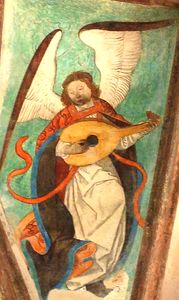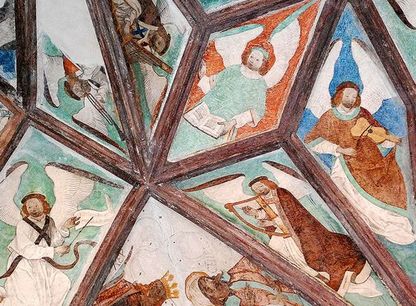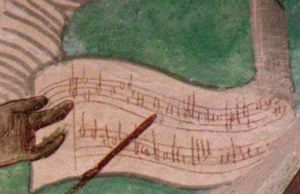
Introduction
Welcome at to the webpages devoted to Kutna Hora’s musical manuscripts of the Middle Ages and Renaissance.
The biggest share in the development of the liturgical chant in the 15th century’s Bohemia are is ascribed to literary brotherhoods. They were societies of educated town citizens that ensured liturgical chant within the Utraquist worship. As a matter of fact, they were little male choirs (10-20 members) organized in the manner of guilds. The existence of such brotherhoods is proven through plentiful documentation are plentifully documented in Kutna Hora. Each of the local churches have their own literary brotherhoods. The ‘High Church’ (St. James) had as many as two choirs, the Czech and the Latin [21]. The existence of this brotherhood can be traced back to 1416 [1].
y Through the devoted work of those brotherhoods, many liturgical books, oftentimes abundantly illuminated, were created. In Kutna Hora, there are rich sources of evidence of this work. For example, in 1502 the inventory of the Church of Virgin Mary ‘na Náměti’ found the following: 10 missals including agenda and ‘special books’, parchment gradual, paper antiphonary, 4 parchment psalters, paper ‘special book’ for singing, 2 hymnals including texts in a folder, 1 small red leather-bound hymnal, 1 textual in white binding, old rubric on paper, and in total 6 hymnals.

Angels playing instruments, painting ceiling. Master of Smíšek Chapel , St. Barbara cathedral.
Kutna Hora had no illumination workshop, therefore most of these books were made in Prague and only some of the non-illuminated manuscripts may have been created by local scribes. There exist records of work of the local scribes in the production of songbooks in 16th century [21].
In the 15th century, the repertoire of these books did not differ much from other contemporary songbooks. Since the contemporary Utraquist Church had very similar liturgy as the Catholic Church, the songbooks contain mostly one-voice Latin chorales and hymns for individual seasons of the liturgical year, which find their origin in the ancient tradition of Gregorian chant. Moreover, some of the sources contain polyphonic scores of both Czech and Latin songs and medieval motets.

Detail of music score in white mensural notation. It is obvious
that it is a part of (Renaissance) polyphonic composition.
These webpages attempt to thoroughly assemble information about Kutna Hora’s musical manuscripts which that have been explored so far. May they be a prompt for further research.
Herein I would like to say a word of thanks to all people who have kindly assisted me in my research: to Jana Bisingerová, PhD., director of the District Archive and Světlana Hrabánková, PhD., director of the Czech Museum of Silver for their assistance with making the photoreproduction of the sources and to their colleagues Vojtěch Vaněk, PhD. and Josef Kremla, MA. for their various professional assistance; to Milada Studničková, PhD. (Institute of Art History of the Academy of Sciences), associate professor Jaromír Černý, PhD., David Eben, PhD., Jan Baťa, MA (Dep. of Musical Science of the Philosophical Faculty of Charles University in Prague) and to Martin Horyna (Dep. of Music of Univ. of South Bohemia in České Budějovice) for their professional assistance and counsel. However, the biggest words of thanks belong to the Lord, for whose glory all these books were made.
CANTICA srpen 2005. Kontakt: kafka@email.cz


